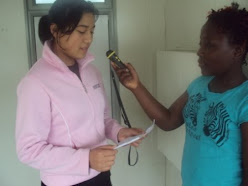Tuesday, August 24, 2010
Open Skill vs Closed Skill success criteria
I have been reading Formative Assessment in Action By Shirley Clarke I found it interesting when reading about co-constructing success criteria with open and closed skills. When reflecting back to my target group of Year 8 boys I realised that they are confident in setting closed skilled success criteria. But still rely on support with open skills. This has made me aware of the power of good exemplars for the students to refer to with their success criteria when working with open skills. Alan Peat provides examples, teaching tips to help with co-constructing success criteria that I am finding useful at the moment.
Wednesday, June 30, 2010
Adora Svitak: What adults can learn from kids
I was just shown this by a colleage Debbie Sorensen for me it confirms the need for change in teaching practice. It has me reflect even further on the purpose of teaching as the facilitator. I recommend this as a must watch.
Sunday, June 27, 2010
Teacher Inquiry Reflection
Over the past few weeks I have dramatically changed my practice. Teaching as a facilitator rather than directively teaching from the front of the room, using questioning to explicitly teach key learning concepts, tools, thinking, key competencies. This is allowing my students to engage in rich and meaningful discussions. For me, it has been brought to my attention the power of explicit teaching in every area is so vitally important. Curriculum areas of reading strategies, writing deeper features and maths. Not only is it in curriculum areas but the need for explicit teaching self talk, modeling thinking, discussing values and the importance, relating it every time back to an experience the students can hold onto.
By practice has change from me doing 70% of the talking, to my students doing 85% of the talking and I am only asking the questions, to allow for them engage in deep thinking. This provides them with the opportunity to question each other.
So, how does this relate to my teacher inquiry on the use of co - constructed success criteria? It has become the "Ripple Effect", (A book that I have recently read by Tony Ryan), I am now seeing the benefits of explicitly teaching components of success criteria ripple off into all areas that I am teaching.
For example, I most recently filmed myself teaching a writing lesson where we were reflecting on the success criteria that we had constructed at the beginning of the term, about the structure of an explanation. Using the analogy of the structure of our classroom. First of all laying the foundation being our Appropriate Title, without the foundation we are unable to have the walls, so it is important it is strong. Then we need to put a wall up and one next to it so that it stays standing, this is our identifying statement. Then we add the next two walls to complete the walls of the classroom, which is our explanation sequence. The roof must go on to close our classroom in which is our summary statement. As we were extending our success criteria we have now discussed the need to add furniture into our classroom. Our desks are our language features which we were introducing similes.
I am now using this style in many areas and seeing my students starting to use other thinking strategies. One student said, last week when we were discussing science investigation structure, "I look it as HAMM. Hypothesis, Aim, Materials, Method, so it is just HAM with an extra M." I took this opportunity to discuss this as an excellent thinking strategy and we used this as a teachable moment around mnemonics.
So where to now?
On reflection I need to change my practice of the style of feedback and feed forward I give my students. I am currently giving most of my feedback and feed forward orally, this needs to become written so that my students are explicitly seeing how to give written feedback and feedforward. I would like to trial giving the feedforward in the way of questions to allow students to start to think about what is their next learning step. Also all my feedback needs to be in relation to the success criteria. I have begun to introduce this with my class in the way of a new teacher, self and peer, highlighting system where colours correspond to different areas. I would like to provide my students with opportunities where they are receiving written feedback and feedforward from me and then move this to a peer and self reflective level.
By practice has change from me doing 70% of the talking, to my students doing 85% of the talking and I am only asking the questions, to allow for them engage in deep thinking. This provides them with the opportunity to question each other.
So, how does this relate to my teacher inquiry on the use of co - constructed success criteria? It has become the "Ripple Effect", (A book that I have recently read by Tony Ryan), I am now seeing the benefits of explicitly teaching components of success criteria ripple off into all areas that I am teaching.
For example, I most recently filmed myself teaching a writing lesson where we were reflecting on the success criteria that we had constructed at the beginning of the term, about the structure of an explanation. Using the analogy of the structure of our classroom. First of all laying the foundation being our Appropriate Title, without the foundation we are unable to have the walls, so it is important it is strong. Then we need to put a wall up and one next to it so that it stays standing, this is our identifying statement. Then we add the next two walls to complete the walls of the classroom, which is our explanation sequence. The roof must go on to close our classroom in which is our summary statement. As we were extending our success criteria we have now discussed the need to add furniture into our classroom. Our desks are our language features which we were introducing similes.
I am now using this style in many areas and seeing my students starting to use other thinking strategies. One student said, last week when we were discussing science investigation structure, "I look it as HAMM. Hypothesis, Aim, Materials, Method, so it is just HAM with an extra M." I took this opportunity to discuss this as an excellent thinking strategy and we used this as a teachable moment around mnemonics.
So where to now?
On reflection I need to change my practice of the style of feedback and feed forward I give my students. I am currently giving most of my feedback and feed forward orally, this needs to become written so that my students are explicitly seeing how to give written feedback and feedforward. I would like to trial giving the feedforward in the way of questions to allow students to start to think about what is their next learning step. Also all my feedback needs to be in relation to the success criteria. I have begun to introduce this with my class in the way of a new teacher, self and peer, highlighting system where colours correspond to different areas. I would like to provide my students with opportunities where they are receiving written feedback and feedforward from me and then move this to a peer and self reflective level.
Thursday, June 3, 2010
ICT Lead Teacher Workshop 3 June
I was exposed to this fun photo site today. What an inspirational way to get students to reflect on the learning that they have done and be creative at the same time. It is easy and fun to use. Check out my reflection.
Wednesday, May 19, 2010
Sunday, May 16, 2010
Shelari
Sharing ideas is the best thing about being a teacher. I have been lucky to have been exposed to Shelfari, which I am planning on introducing into my reading programme over the coming term. It is an awesome way for students to keep a book shelf of what they have read and share their reviews and read other people's ideas.
Tuesday, April 20, 2010
Trail of Next Step for Creating Success Criteria
After reflecting during the holidays on how my students were progressing towards developing and working towards success criteria, I was happy. However, I was still the one doing all the work. I had not yet tried anything that would allow them to have ownership. Today was the day!
I started off by sharing this photo with them:
 It was something they knew a lot about as we have recently completed our study on Anne Frank. Then we looked at the 6 levels of questioning. Together we came up with questions that would be relvant to each level. From there we created our own assessment rubric for question in our coming inquiry.
It was something they knew a lot about as we have recently completed our study on Anne Frank. Then we looked at the 6 levels of questioning. Together we came up with questions that would be relvant to each level. From there we created our own assessment rubric for question in our coming inquiry.Here is what we came up with:

This was a positive experience, that I feel the students now own and are able to clearly understand the different levels of questions.
Subscribe to:
Posts (Atom)



